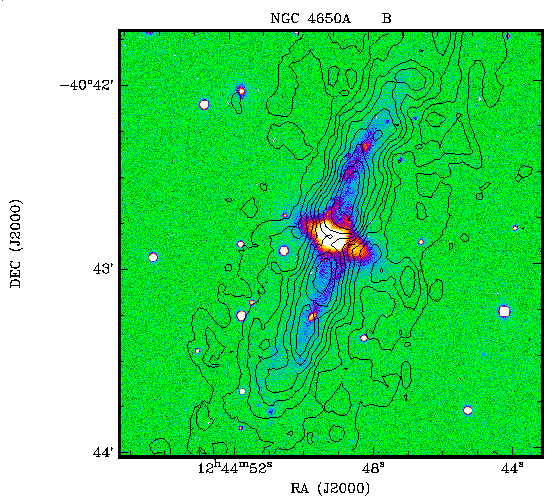A new twist to polar rings
One of astronomy's great challenges is to understand the nature of the mysterious dark matter that pervades the Universe. Even its distribution around individual galaxies has eluded us. Now, new Australia Telescope observations of the polar ring galaxy NGC 4650a suggest that the dark matter in this galaxy lies in a flattened distribution aligned with the polar ring.
Polar ring galaxies have a luminous outer ring of stars, gas and dust lying nearly perpendicular to the plane of the host galaxy. The ring rotates, at speeds similar to those of the galaxy's stellar component. By examining the two dynamical systems ­p; the ring and the central stellar component ­p; we can constrain the distribution of the dark matter in three dimensions.
NGC 4650a, the best-studied polar ring galaxy, has HI associated with its polar ring. N-body modelling of the galaxy has shown that the observed distribution of HI is consistent with the galaxy's dark matter being associated with the polar structure. But this modelling was not conclusive, as it was based on low-resolution HI observations.
The galaxy has now been observed at higher resolution with the Australia Telescope Compact Array. The results show that the HI lies in an edge-on disk, not a ring ­p; contrary to previous models based on the light distribution in the ring.
Furthermore, there are spiral arms in the disk. Their presence implies that the disk structure is massive. This in turn suggests that this galaxy's dark matter may be related to the HI and not to the central stellar component; it may lie in a flattened distribution aligned with the polar ring. The new observations support models in which the dark matter is distributed in this way.
There is other evidence that HI and dark matter are closely related: for instance, the rotation curves of spiral galaxies imply that the ratio between dark matter and gas surface densities is roughly constant. NGC 4650a lends weight to the association.
M. Arnaboldi, K. C. Freeman (Mount Stromlo and Siding Spring Observatories);
F. Combes (DEMIRM, Observatoire de Paris-Meudon); B. Koribalski, T. Oosterloo (ATNF)

NGC 4650a: a high-resolution 21-cm ATCA image (contours), overlaid on the ESO NTT B-band image of the galaxy's central region. Copyright © CSIRO Australia Telescope National Facility
More:
News
Public
